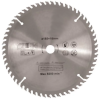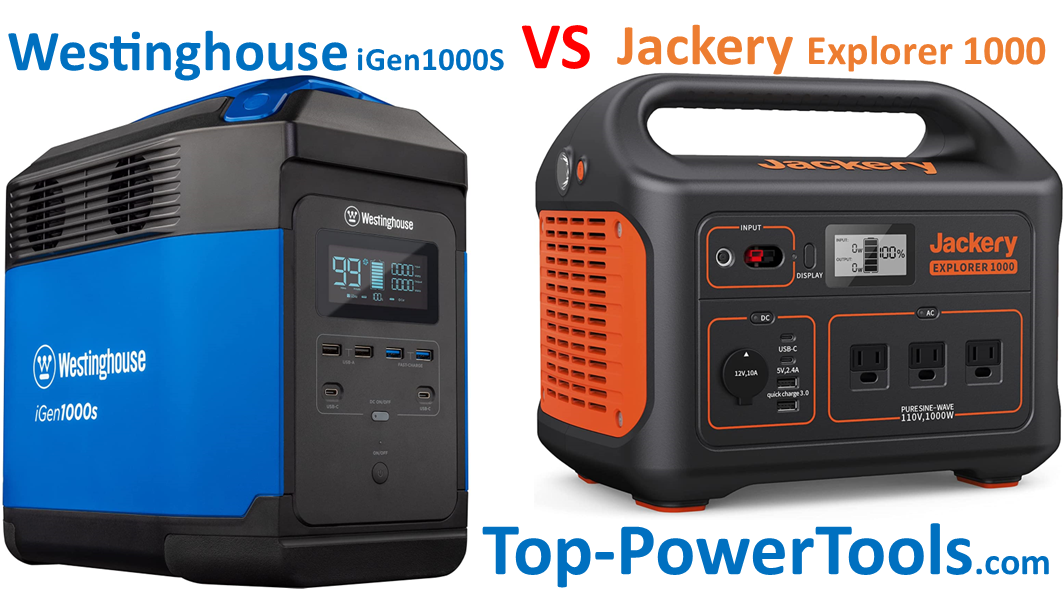We’ll be comparing two fairly similar portable battery power stations, or solar generators, in this review. While the Westinghouse iGen1000S and Jackery Explorer 1000 have a lot of common ground, they have their differences. All will be revealed in this comparative review of the Westinghouse iGen1000S vs Jackery Explorer 1000.
We’ll be taking an in-depth look at two of the best value solar generators, considering the pros and cons of both models. Note that the emphasis here is on the best value or best bang for your buck. You could pay considerably more for a Goal Zero equivalent portable battery power station. Undoubtedly, the Goal Zero solar generator will offer better technology and design. It is probably more durable than either the Westinghouse iGen1000S or Jackery Explorer 1000. Goal Zero products are notably more expensive than the brands featured in this review. Hence the notion that we’re considering price vs quality and features as the priority for good value.
Both these models are very reasonably priced, I wouldn’t go so far as to say cheap. Solar generators are not cheap. Both the Westinghouse and Jackery portable power stations offer pretty good quality. This means they are not the cheapest. There are cheaper options, but I’d think twice about buying a really cheap power station. Essentially, the Westinghouse iGen1000S and Jackery Explorer 1000 are good quality machines at delightfully affordable prices. Ergo, great value for money.
In many ways, Jackery has the advantage here. The brand has become an established leader in the affordable portable power station market. The Jackery Explorer 1000 is a best-seller and for good reason. Despite being the underdog (in marketing terms), the Westinghouse iGen1000S actually offers more features and an incredible inverter – probably the best in its class.
While Westinghouse has gained a stellar reputation in the portable gas generator market (in a relatively short time), the brand is not yet recognized as a competitor amongst the well-known solar generator brands. I see no reason why Westinghouse shouldn’t become one of the leaders in this market. They are certainly a force to be reckoned with when it comes to top-quality, great value generators.
Depending on the retailer, the Jackery Explorer 1000 is probably going to cost you a couple of hundred dollars less than the Westinghouse iGen1000S. I reckon the Westinghouse is the better portable power station. Around $200 better? That would be a matter of personal opinion. I’ll leave you to decide which is actually the best value solar generator.
Westinghouse iGen1000S Review
Features:
- Built-in 1008-Watt hours lithium-ion battery.
- Dimensions (L x W x H): 12.3 x 8 x 12.4 inches; Weight: 31.1 pounds
- Charges up to 8 devices at a time that can power up to 142 hours of lights, 18 hours of TV, 109 smartphone charges, 40 laptop charges, 151 drone charges, and 59-79 hours on select CPAP devices
- Six USB ports including USB-C and Quick Charge 3.0 port, one 12V car cigarette outlet, DC outputs, 12V DC input, and 6 120V household outlets
- Four charging methods with included car charger, wall charger, optional solar panel charger for sustainable use, or a portable generator
Review:
The Westinghouse iGen1000S is a great, very practical power supply for camping, tailgating, or any outdoor activity. With a great pure sine wave inverter, supplying 1,500W running power and 3,000W surge capacity, it’s also a pretty powerful backup indoor generator to use at home during an outage.
I really like the design. The box-like tower shape makes it really easy to store or transport. Dimensions of 12.4” (L) X 8” (W) X 12.3” (H) make it a very compact unit, especially for the power it delivers. The Westinghouse 1,500W portable power station weighs 31-pounds. With a carrying handle at the top of the machine, it is as portable as they come.
The Westinghouse iGen1000S stores power using a 1008 watt-hour lithium-ion, Nickel Manganese Cobalt Oxide (NMC) battery. This type of lithium-ion battery is quite commonly used in solar generators as it is reasonably inexpensive and offers pretty good battery life, as well as efficient power delivery. The battery is rated for 800 cycles, up to 60% discharge.
To give you easy access to the 1,500 watts of constant, pure sine wave AC power, the iGen1000 has six AC outlets at the back of the power station. All the outlets are electronically monitored for user safety and will trip if the circuits are overloaded, or a short circuit occurs. The system will also shut down automatically if it overheats. Warning icons on the user panel will alert you to any of these situations.
The Westinghouse iGen1000S is capable of supplying up to 300W DC power continuously. There is absolutely no shortage of DC outlets: 2 X USB A ports, 2 X USB C, and 2 X USB A rapid charging ports. It also includes a 12VDC automotive auxiliary style outlet.
As with most similar solar generators, the Westinghouse offers multiple charging options. A wall and car charger are supplied with your purchase. The 120V AC wall charger is really good, charging the battery from 0% to 80% in only 2-hours. To fully charge the battery, it will take about 3-hours. The car charger is not as impressive, they never are. It will take around 12-hours to charge the battery using the 12V outlet in your car. This is okay on long road trips. It has a 12VDC input, allowing for solar charging, which will take 7 – 9 hours. Solar kits are sold separately. Although a solar MC4 to XT60 input cable is supplied with the unit.
The iGen1000S has a comprehensive and easy to use LCD display screen. A large numeric display boldly shows the time remaining in minutes or hours. When the battery is charging, it will tell you how long before the battery is fully charged. Alternatively, it will display the battery time remaining whilst discharging. In other words, when you’re using the Westinghouse to power devices. A large battery icon provides a quick reference to the battery status. Beneath this, is a numeric display indicating battery percentage. It also displays the input and output wattage, along with all sorts of system information, like fan on or off, and emergency warnings.
Considering the quality standard and features offered by the Westinghouse iGen1000S, I see it as really good value for money. I’ve genuinely come to respect the brand as a manufacturer of top-quality, great value portable gas generators. I’m expecting similarly great things from the Westinghouse range of portable power stations. Generally, Westinghouse quality and customer service is superb, and this model has a 2-year warranty.
Westinghouse iGen1000S Downloads:
Jackery Explorer 1000 Review
Features:
- Features a 1002Wh(46.4Ah) lithium battery capacity, 1000W continuous and 2000W surge power.
- Multiple Output Ports: Two USB-C, two USB, one DC car port & three pure sine wave AC outlets.
- Efficient solar charging with a built-in MPPT charge controller. Can accommodate two SolarSaga 100W solar panels (sold separately) allows fast, eco-friendly charging. Completely charge the battery with full sun in just 8 hours.
- Weighs only 22lbs and has a solid handle for easy carrying.
- LCD screen with charge/discharge data and battery life status for safety and ease of use.
Review:
The Jackery Explorer has about the same battery storage as the Westinghouse iGen1000S – 1002 WH. However, here the similarities mostly end. The Jackery is not equipped with an inverter that can match the power output that you get from the Westinghouse. Nor does it have as many outlets and the wall charger is not as powerful either. Then again, this portable power station costs around 200 bucks less than the Westinghouse model. A bit of a compromise for a pretty substantial saving.
The pure sine wave inverter supplies 1,000 watts continuously, with a peak capacity of 2,000W – 50% less than the Westinghouse iGen1000S. Nonetheless, the Jackery Explorer 1000 is a nifty companion for outdoor activities and basic power during an outage. It has 3 X 110V AC outlets.
DC outlets may not be as plentiful as those found on the Westinghouse solar generator, but just as versatile. The Jackery Explorer 100 has a single USB A port, a USB C port, and a USB 3.0 quick charge port. It also has a 12VDC outlet in the car cigarette lighter format. An Anderson connector allows you to connect solar panels up to 163W (12 – 30V). Solar panels are sold separately.
Charge times are acceptable but not fantastic. Using the 120V AC wall charger, you can expect the battery to charge in about 7-hours. The car charger should have the battery charged to full in approximately 14-hours. If you’re using 2 X 100W solar panels, in good sunlight, it could take as little as 8-hours to charge the battery.
The Jackery Explorer 1000 has a fairly basic screen, displaying battery status, as well as input and output wattage. The screen isn’t very large but is easy to use and certainly not complicated.
Given the smaller inverter and fewer outlets, the Jackery Explorer 1000 is lighter than the Westinghouse iGen1000S at 22-pounds. It measures 13.1” (L) X 9.2” (W), 11.1” (D), and has a comfortable carrying handle. The Jackery Explorer 1000 is every bit as portable as any of the best portable power stations.
I would rate the Jackery and Westinghouse solar generators as equals in the quality department. They both utilize a lithium-ion NMC battery which is rated for about 500 cycles (up to 80% discharge), or 800 cycles (up to 60% discharge). Both the Jackery Explorer 1000 and Westinghouse iGen1000S are equipped with highly efficient MPPT solar chargers. Making them eco-friendly solar generators.
Jackery Explorer 1000 Downloads:
The Bottom Line
In the end, choosing between these two portable power stations may probably come down to power requirements vs price. The Westinghouse iGen1000S has a much more competent inverter and twice as many AC outlets. It also has a greater array of USB ports and a more sophisticated display screen.
On the other hand, the Jackery Explorer 1000 is noticeably lighter – about 30% and it is about 20% cheaper. In my opinion, both are great deals. It really depends on your priorities which one is best for your requirements.
At the time of writing this review, Amazon has an amazing discount on the Westinghouse iGen1000S, making it cheaper than the Jackery Explorer 1000. I’d say this discount places the Westinghouse at the top of the best value portable power station hierarchy.




